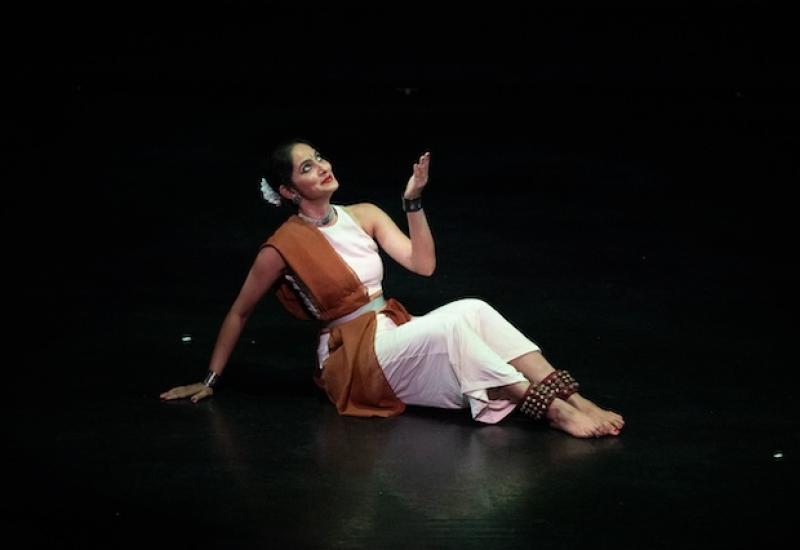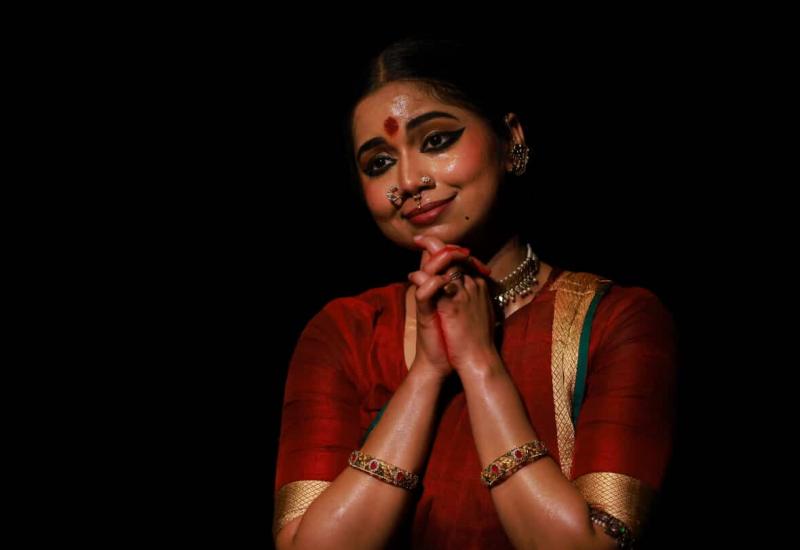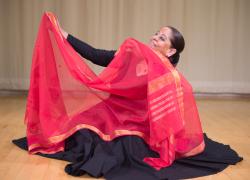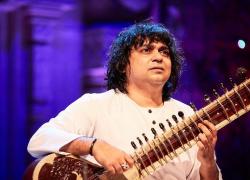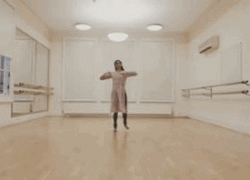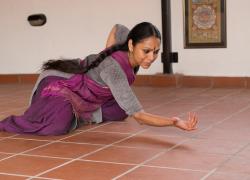Mythili Prakash: Here & Now
Fairfield Halls, Croydon
18 October 2019
Part of Dance Umbrella
Reviewed by Pranav Yajnik
The last time I saw Mythili Prakash perform was in 2007, when she presented Stree Katha. Here and now (if the pun will be forgiven): the aesthetics have changed, but the dancer and the conceptualisation of this performance reminded me with force of what I had seen twelve years ago: intelligence, profundity and a willingness to challenge things from the inside out.
Here & Now explores the ambivalence of the human relationship with Time, and its capriciousness. It is not the first time that the relationship has been explored by an Indian classical dancer; Aditi Mangaldas’ similarly conceptualised but differently executed 2007 piece Timeless had examined it through a contemporary choreography. Mythili Prakash too has chosen to go beyond the strictures of classicism for Here & Now. Indeed, the pure dance of bharatanatyam appeared in a hundred tiny gleaming but disconnected shards, set like diamonds in the steel of a movement-based choreography rooted in bharatanatyam but which had moved beyond it to a freer expression. No thai hat thai his here.
In moving outside the traditional movement repertoire of bharatanatyam, Mythili Prakash harnessed a spacious physical vocabulary, sweeping low on lunges with her long legs and stretching her long arms to the sky in sequences of movements that flowed seemingly naturally from one another. Within that new vocabulary, she danced with complete commitment, whipping her elongated frame into turns and bringing it up short to reverse movements along the paths they had just taken. Yet it was not the precision or the flexibility, or even the self-belief with which she danced that marked the audience: it was her humanity. Two emotional vignettes glowed with internal colour through the dun lighting of the performance. The first was a cyclical image of a person heaping up the sand on a beach; the sea washes the sand away and again until she stares in disbelief at the grains of time slipping through her fingers. And if that image tended toward despair, the second verged on excoriating. Against Sushma Somasekharan’s nostalgic lullaby refrain, a mother talked to her child and put it to bed, smiling in bewilderment at how it could possibly have grown up so in so short a time. Suddenly, the warmth was searingly intercut by a scene of the mother staring in horror and clutching her womb; and then even as she rocked her baby to sleep, by death rising behind the wrinkles of her face, until Time pulled her out of the moment as the vignette dissolved around her, and the character was sent hurtling back into the war that moments in time wage for our attention every day. In both these scenes, Mythili Prakash’s remarkable expressional skill yoked to the music was able to convey a power which went beyond the mere narrative.
Those who have seen any of Akram Khan’s productions would have felt the set design, the lighting and the presentation very familiar. (Indeed his name featured more than once in the programme and Mythili Prakash has danced in his Outwitting the Devil.) Although therefore the design of the performance was clearly a level above the usual Indian classical dance fare, by now it does seem rather formulaic. Furthermore, the persistently dim brown lighting aesthetic flattened the dancing and did nothing to help the audience see the detail of Mythili Prakash’s abhinaya. However, whatever drawbacks the visual presentation had were not matched by the auditory experience. Sushma Somasekharan’s honeyed voice was given full focus, with unintrusive instrumental backing; Sumesh Narayanan’s live percussion was full of surprising and captivating patterning. Both of these artists provided more than enough intensity for the strength of Mythili Prakash’s theme.
And then, just as the audience was fully engaged, the performance ended in medias res. It was difficult to know whether this was an artistic decision: after all, the audience was in the moment with her, and she ripped the illusory tapestry of her performance from before our eyes as abruptly as the mother character had been pulled out of the moment earlier in the choreography. But there was a definite sense that the audience would willingly have sat to watch this remarkable dancer and her ideas for much longer than she gave them.







